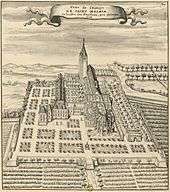Micy Abbey
Micy Abbey or the Abbey of Saint-Mesmin, Micy (French: Abbaye Saint-Mesmin de Micy), sometimes referred to as Micy, was a Benedictine abbey near Orléans at the confluence of the Loire and the Loiret, located on the territory of the present commune of Saint-Pryvé-Saint-Mesmin.

History
The monastery was founded around 501 on land granted by Clovis I to Saint Euspicius and his nephew Saint Mesmin or Maximin. Nothing remains of the buildings.
From Micy Abbey, monastic life spread within and around the diocese of Orleans. Saint Liphardus and Saint Urbicius founded the Abbey of Meung-sur-Loire; Saint Lyé (Laetus) died a recluse in the forest of Orléans; Saint Viatre (Viator) in Sologne; Saint Doulchard in the forest of Ambly near Bourges. Saint Leonard introduced the monastic life into the territory of Limoges; Saint Almir, Saint Ulphacius and Saint Bomer in the vicinity of Montmirail; Saint Avitus (died about 527) in the district of Chartres; Saint Calais (died before 536) and Saint Leonard of Vendœuvre (died about 570) in the valley of the Sarthe; Saint Fraimbault and Saint Constantine in the Javron forest, and the aforesaid Saint Bomer (died about 560) in the Passais near Laval; Saint Leonard of Dunois, Saint Alva and Saint Ernier in Perche. Saint Laumer (died about 590) became Abbot of Corbion. Saint Lubin (Leobinus), a monk of Micy, became Bishop of Chartres from 544–56. Finally Saint Ay (Agilus), Viscount of Orléans (died after 587), was also a protector of Micy.
The monks originally followed the Rules of Saint Basil and Saint Anthony, but in the late 8th century Theodulf, bishop of Orléans, introduced the Rule of Saint Benedict.
In 1608, following a period of conflict, François de La Rochefoucauld, bishop of Clermont, persuaded Pope Paul V to order the Benedictines to be turned out of the abbey and to be replaced by a community of Feuillants.
The abbey was suppressed during the French Revolution and the buildings demolished.
In 1939 a community of Carmelites took up residence on the former abbey site, and remain there, as the Carmel de Micy-Orléans.
References

External links
- Micy
- History of Saint-Pryvé-Saint-Mesmin (in French)